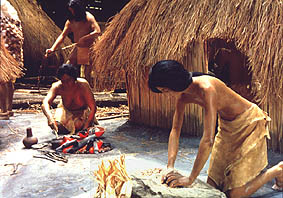
Grinding maize, Cahokia Mounds Museum.

Grinding maize, Cahokia Mounds Museum. | For the household, not only did maize give some insurance against failure of other food sources throughout the year, it could be ground and cooked in ways so that it could be eaten in quantities by both the very young and very old. Much as today's bottled baby foods reduce the frequency and intensity of nursing episodes for mothers, maize gruel and pastes may have allowed Mississippian mother's more flexibility in child care. Younger family members or the elderly who could not perform physical tasks could provide child care, including the feeding of not yet weaned infants. The ability of non-lactating household members to provide care would permit the mother to do physical economic tasks away from the infant. Perhaps also these maize gruels with their high caloric content allowed Mississippian mothers to wean their infants at an earlier age. Suppression of the mother's lactation may have increased her fertility slightly, perhaps allowing for more rapid population growth. |